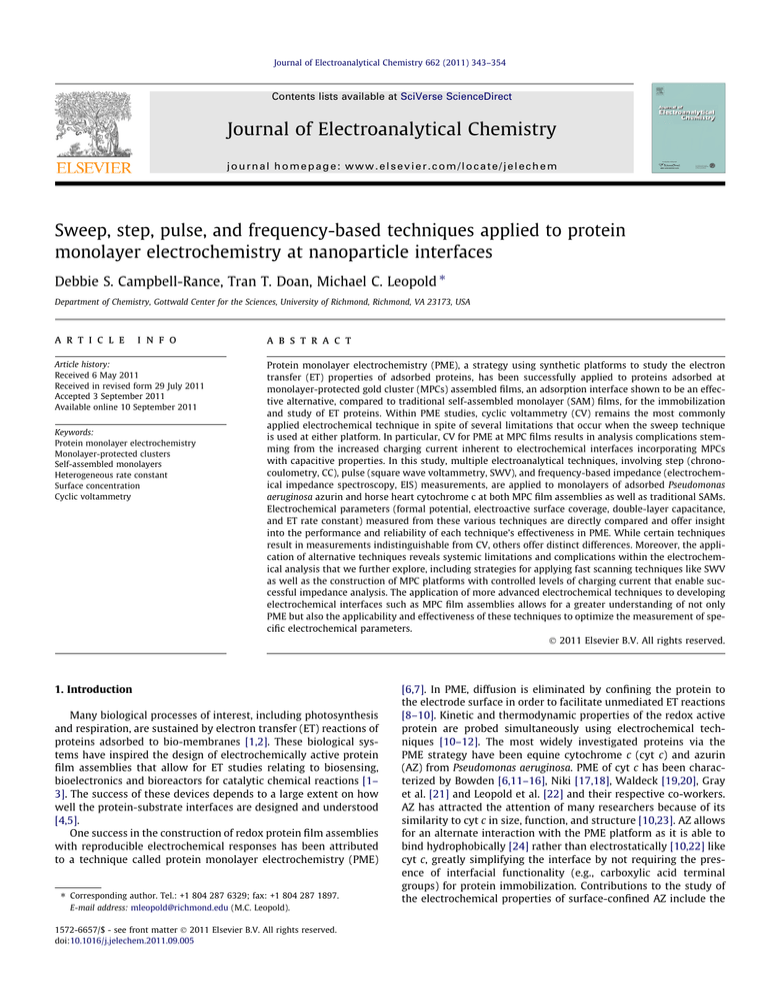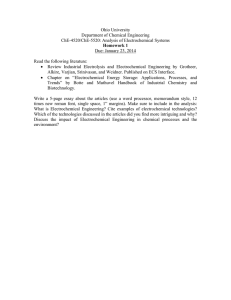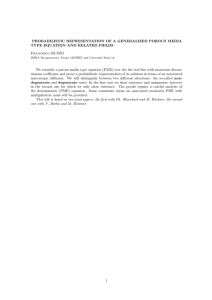
Journal of Electroanalytical Chemistry 662 (2011) 343–354
Contents lists available at SciVerse ScienceDirect
Journal of Electroanalytical Chemistry
journal homepage: www.elsevier.com/locate/jelechem
Sweep, step, pulse, and frequency-based techniques applied to protein
monolayer electrochemistry at nanoparticle interfaces
Debbie S. Campbell-Rance, Tran T. Doan, Michael C. Leopold ⇑
Department of Chemistry, Gottwald Center for the Sciences, University of Richmond, Richmond, VA 23173, USA
a r t i c l e
i n f o
Article history:
Received 6 May 2011
Received in revised form 29 July 2011
Accepted 3 September 2011
Available online 10 September 2011
Keywords:
Protein monolayer electrochemistry
Monolayer-protected clusters
Self-assembled monolayers
Heterogeneous rate constant
Surface concentration
Cyclic voltammetry
a b s t r a c t
Protein monolayer electrochemistry (PME), a strategy using synthetic platforms to study the electron
transfer (ET) properties of adsorbed proteins, has been successfully applied to proteins adsorbed at
monolayer-protected gold cluster (MPCs) assembled films, an adsorption interface shown to be an effective alternative, compared to traditional self-assembled monolayer (SAM) films, for the immobilization
and study of ET proteins. Within PME studies, cyclic voltammetry (CV) remains the most commonly
applied electrochemical technique in spite of several limitations that occur when the sweep technique
is used at either platform. In particular, CV for PME at MPC films results in analysis complications stemming from the increased charging current inherent to electrochemical interfaces incorporating MPCs
with capacitive properties. In this study, multiple electroanalytical techniques, involving step (chronocoulometry, CC), pulse (square wave voltammetry, SWV), and frequency-based impedance (electrochemical impedance spectroscopy, EIS) measurements, are applied to monolayers of adsorbed Pseudomonas
aeruginosa azurin and horse heart cytochrome c at both MPC film assemblies as well as traditional SAMs.
Electrochemical parameters (formal potential, electroactive surface coverage, double-layer capacitance,
and ET rate constant) measured from these various techniques are directly compared and offer insight
into the performance and reliability of each technique’s effectiveness in PME. While certain techniques
result in measurements indistinguishable from CV, others offer distinct differences. Moreover, the application of alternative techniques reveals systemic limitations and complications within the electrochemical analysis that we further explore, including strategies for applying fast scanning techniques like SWV
as well as the construction of MPC platforms with controlled levels of charging current that enable successful impedance analysis. The application of more advanced electrochemical techniques to developing
electrochemical interfaces such as MPC film assemblies allows for a greater understanding of not only
PME but also the applicability and effectiveness of these techniques to optimize the measurement of specific electrochemical parameters.
Ó 2011 Elsevier B.V. All rights reserved.
1. Introduction
Many biological processes of interest, including photosynthesis
and respiration, are sustained by electron transfer (ET) reactions of
proteins adsorbed to bio-membranes [1,2]. These biological systems have inspired the design of electrochemically active protein
film assemblies that allow for ET studies relating to biosensing,
bioelectronics and bioreactors for catalytic chemical reactions [1–
3]. The success of these devices depends to a large extent on how
well the protein-substrate interfaces are designed and understood
[4,5].
One success in the construction of redox protein film assemblies
with reproducible electrochemical responses has been attributed
to a technique called protein monolayer electrochemistry (PME)
⇑ Corresponding author. Tel.: +1 804 287 6329; fax: +1 804 287 1897.
E-mail address: mleopold@richmond.edu (M.C. Leopold).
1572-6657/$ - see front matter Ó 2011 Elsevier B.V. All rights reserved.
doi:10.1016/j.jelechem.2011.09.005
[6,7]. In PME, diffusion is eliminated by confining the protein to
the electrode surface in order to facilitate unmediated ET reactions
[8–10]. Kinetic and thermodynamic properties of the redox active
protein are probed simultaneously using electrochemical techniques [10–12]. The most widely investigated proteins via the
PME strategy have been equine cytochrome c (cyt c) and azurin
(AZ) from Pseudomonas aeruginosa. PME of cyt c has been characterized by Bowden [6,11–16], Niki [17,18], Waldeck [19,20], Gray
et al. [21] and Leopold et al. [22] and their respective co-workers.
AZ has attracted the attention of many researchers because of its
similarity to cyt c in size, function, and structure [10,23]. AZ allows
for an alternate interaction with the PME platform as it is able to
bind hydrophobically [24] rather than electrostatically [10,22] like
cyt c, greatly simplifying the interface by not requiring the presence of interfacial functionality (e.g., carboxylic acid terminal
groups) for protein immobilization. Contributions to the study of
the electrochemical properties of surface-confined AZ include the
344
D.S. Campbell-Rance et al. / Journal of Electroanalytical Chemistry 662 (2011) 343–354
groups of Cavalleri et al. [23], Ulstrup [24–26], Jeuken and Armstrong [27], Gray et al. [28], Martin et al. [29], and Leopold [30,31].
The traditional platforms for PME include Langmuir–Blodgett
(LB) films, self-assembled monolayers (SAMs) and monolayer-protected cluster (MPC) film assemblies [6,13,31,32]. Even though this
PME strategy has been used successfully to investigate the ET of
proteins and determine valuable thermodynamic and kinetic
parameters, the technique is not without limitations. Broadened
voltammetry is a common anomaly of this assembly, resulting in
full width at half-maximum (FWHM) values that deviate significantly from the theoretical value of 90 mV for an optimally adsorbed system [33]. This non-ideality has been previously
attributed by Bowden and coworkers to the presence of a heterogeneous population of adsorbed cyt c at the SAM interface [14]. In another report they demonstrate that the topography of the SAM’s
underlying gold support is a contributing factor to interfacial heterogeneity [16]. Thus, uniform adsorption of the redox protein to a
suitable substrate is central to the optimization of the PME platform. An additional limitation is the low signal-to-background current ratio, a consequence of monolayer or sub-monolayer protein
coverage and/or adsorption of protein in non-optimal ET orientations [13].
In light of these limitations, research aimed at optimizing PME
strategies is ongoing and includes the exploration of new materials
able to interface electrode with protein. One approach is based on
adsorbing proteins to citrate stabilized gold nanoparticles (NPs) to
improve direct ET [34–36]. This idea is motivated by the fact that
NPs have unique properties such as large surface-to-volume ratio
(increase protein coverage), biocompatibility with protein (preserving its electroactivity), and the ability to act as a conduit for
ET to occur between electrode and protein [35,37–39]. This approach, however, has been shown to exhibit slow kinetics, increased background signals and non-ideal electrochemistry
[40,41]. An alternative PME strategy developed in our lab involves
adsorbing proteins to covalently networked films of alkanethiolate-stabilized gold NPs known as monolayer-protected clusters
(MPCs) [22,30,31,42]. Prior studies using the MPC film assemblies
focused on the voltammetry of cyt c and AZ. In the case of cyt c,
MPC films featuring a variety of linking methods and different core
sizes were studied. This work established a clear dependence of
background charging current on the linking mechanisms used during the film assembly with covalent, dithiol interparticle linking
resulting in low charging current [22]. Studies of AZ adsorbed at
MPC film assemblies looked at the distance dependence of ET
kinetics by varying the chain length of the alkanethiolate SAM
and found a notable lack of distance dependence for heterogeneous
ET reactions [30]. Another report used cyclic voltammetry (CV) and
atomic force microscopy (AFM) to show that MPC film assemblies
provided a more homogeneous adsorption interface that yielded
cyclic voltammograms with FWHM values less than 110 mV compared to the traditional PME which has values in the range 120–
130 mV [31].
While the primary electrochemical technique utilized in most
PME reports is CV, our study seeks to expand the scope of this
interrogation to include step, pulse and frequency based electrochemical techniques applied to both SAM and MPC adsorption
platforms. Even though CV is capable of estimating both the kinetic
and thermodynamic properties of the adsorbed protein, it is one of
the least effective electrochemical techniques in terms of discriminating against non-Faradaic (background) current [33]. Consequently, the accuracy with which surface coverage is evaluated is
a concern since it is possible that portions of the protein signal
are obscured by the background signal [30]. The discrimination
of background current has been shown to be particularly important
with electrode interfaces featuring additional capacitive components such as NPs [22]. In this report, double potential step
chronocoulometry (CC), square wave voltammetry (SWV) and electrochemical impedance spectroscopy (EIS) are used for electrochemical analysis of adsorbed monolayers of cyt c and AZ at
various SAM and MPC modified electrodes. The results from these
techniques were compared to traditional CV analyses of the same
systems. The selection of these particular techniques is strategic
in that, compared to CV they are specifically geared to discriminate
against charging current, a benefit that, in theory, should result in
greater sensitivity (i.e., increased signal-to-noise ratios) and more
accurate measurements of protein surface coverage [43–45].
Hence the focus of our work is to establish the usefulness and
adaptability of these alternative electrochemical techniques in
PME scenarios, including those incorporating NPs as a part of the
protein adsorption platform.
2. Experimental details
2.1. Reagents and materials
Ultrapure water (UP H2O, 18 MX) was used to prepare all solutions and rinse glassware and electrochemical cells. All thiols were
purchased from Sigma-Aldrich and were used without further
purification. Thiol solutions (5 mM) containing neat ethanol were
used for SAM assembly as previously described [30,46]. Gold electrodes (Evaporated Metal Films Inc.) were electrochemically
cleaned prior to SAM assembly [12]. Similar protocol was followed
in the preparation of Pseudomonas aeruginosa azurin and equine
cytochrome c as reported in prior studies [22,30,31]. Alternate
purification protocols were also explored on AZ solution prepared
from the lyophilized protein in 4.4 mM potassium phosphate buffer (KPB, pH 7.0, l = 10 mM) to determine if samples contained
more than one population of AZ on the surface (Supplementary
data).
2.2. Equipment
Cyclic voltammograms (100 mV s1, unless otherwise noted),
chronocoulograms and square wave voltammograms were recorded with a CH Instrument potentiostat (Model 400) while
impedance spectra were recorded with the Gamry Reference 600
potentiostat, both of which incorporated a Faraday cage during
measurements. SWV simulations were acquired with the DigiElch
Professional (Version 6.F) for simulating electrochemical processes.
In order to create the square wave voltammograms, the software
required the input of the relevant experimental parameters from
the SWV electrochemical waveform as well as the ET coefficient
(a), the formal potential (E°0 ) and the heterogeneous rate constant
(ket).
2.3. MPC synthesis
MPCs were prepared using established protocols (Brust reaction) [22,30,31]. In this preparation, chloroauric acid (HAuCl4)
and 1-hexanethiol (C6) or 1-dodecanethiol (C12) served as the precursor and capping agent, respectively. The MPCs produced possessed an average core composition of 225 gold molecules
(Au225) with 75 C6 or C12 thiolate ligands and average core diameter of 2.03 ± 0.95 nm as determined using nuclear magnetic resonance and transmission electron microscopy analyses, respectively
and was in agreement with literature reports [30,31].
2.4. Electrode modification procedures
Evaporated gold substrates were mounted in electrochemical
sandwich cells [22], where a built-in viton ring further defined a
ID
219486
Title
Sweep,step,pulse,andfrequency-basedtechniquesappliedtoproteinmonolayerelectrochemistryat
nanoparticleinterfaces
http://fulltext.study/article/219486
http://FullText.Study
Pages
12



